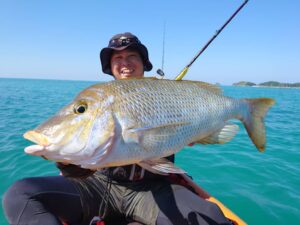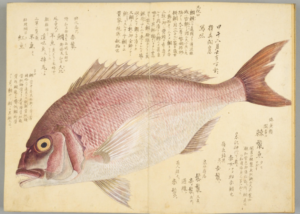The Japanese Approach to Carp Fishing
Carps are a very familiar fish for Japanese people. There are many ponds that have carp all over Japan. And I can even say that it may be hard to find a pond without any carps. We love carps with colors, and we had been breeding carps for their unique colors. In Europe, colored carps are called Koi carp, but the Japanese word koi stands for the carp in general. We call the colored carps Nishiki-goi (nishiki means a type of colorful kimono, goi is changed form of koi).
As for angling, carps have been a very good target fish. It grows very big, and you can go fishing for carp easily as it is easy to go to the place where carp are.
There are many ways to catch carps in Japan, but in this article, I would like to show you one technique called the Suikomi method.
(Note: one of my blogs was about carp fishing in general. Here is the link for it. )
Species; the difference from European carps
In Japan, the carp you see are full scaled carp, with the lower back height. Since rivers are one of the main living space for carp in Japan, this slim shape is suitable for their survival.
Carp in Japan is often labeled as a common carp (or Eurasian carp, Cyprinus carpio). But actually, current Japanese carp are descendants of Amur carp (Cyprinus rubrofuscus), according to its genetics. While Eurasian carp is the native species in Europe, Amur carp originated in Amur river areas (China, Vietnam and Laos). The scientific discussion about the real origin of Japanese carp (including colored Koi carp) is continuing and not entirely settled. However, it explains the difference of their appearances between Japanese carp and European carp, and their behavior difference after it is hooked may be comfortably explained.
Japanese carp carry a lot of features to live in the rivers (which may be coming from the Amur river ancestor). Scales cover its entire body, and have a low height to reduce the water resistance. And it has a relatively larger tail fin to propel itself inside the moving water.
Behavior of Japanese carp does not differ so much as European carp. They are omnivorous and eat aquatic plants (including seeds), as well as zooplankton, insects, worms, crustaceans, shells, water snails, and fish eggs. In Japan, if we name familiar human foods, they are said to feed on grains, corn, potatoes, sweet potatoes, breads, noodles (Udon), etc. They take their food by swallowing it with some water and filter what they want to eat. Their mouth shape is suitable for this way of eating, and it protrudes downward slightly to function like a hose. Though there are no teeth on the lips, they have teeth down inside their throat (on the inferior pharyngeal bones) and they grind the hard matter for digestion.
The spawning time of carps in Japan is from spring to summer. They lay their eggs on the water plants near the shore, in some cases a few times in one season. After 3 to 6 days of spawning, the baby carps hatch and it is said that it grows up to 10 - 15 cm in their first year. In three years, it becomes 30 - 40 cm long, in the wild environment.
Fishing Suikomi method
This method is using their behavior of their eating. When they search and eat something from the bottom, they swallow their food with the wand or mud and water around. They repeat this swallowing actions to take what they want from what they take in their mouth.
The Suikomi method uses the paste bait and forms it into a dumpling. The dumplings are made from various ingredients. One of the most popular choices for anglers are to use the packed pre-mixes packs from the fishing store.
The ingredients of pre-mixed packs are ground fish pellets, dried and ground pupa of silkworm, corn, flour, ricebran, wheat, potatoes, sweet potatoes, ground water snails, etc. Since carp eats various kinds of foods the list goes on. These ingredients are mostly made into powders or small pieces and adjusted to form a nice dumpling. If you have done European style feeder fishing, then you know the importance of the bait. This is also the key factor in the Suikomi method. The dumpling should be hard enough to endure the long cast, while soft enough to be melting in the water after a certain duration of time.
This method uses a unique rig. It has a small spring to hold the paste bait in place, with several pieces of hooks near it. These hooks are to be buried into the dumpling of bait. And the one hook at the far end of the rig is for another bait.
It often uses a rod of 3 to 4 m length, similar to the surf casting rod to cast away the sinker of 40 to 55 g (10 to 15 gou in Japanese sinker unit). The main line is 0.33 mm or thicker. Its sinker is the flat line through type, in round or bell shaped. Following the short rubber pipe, the swivel carries the rig with spring and several hooks.
In this rig, the line is a soft braided line and the hooks are a kind of Iseama type. For the types of Japanese hooks, please refer to this blog article of mine. The hooks are said to be better with slightly thinner wire than the one made for saltwater fish, because the lighter hooks are easy to get swallowed by carp.
As for the hooked bait, anglers are using corn, worms, a different kind of paste bait, breads, pupa of silkworm etc.
In current Japan, anglers seldom eat carp after catching it, and they look at this fish as a game fish. From this viewpoint, some people hesitate to use this rig as this rig tends to give bigger damage to the fish. These anglers are now turning to European style carp fishing or less harmful rigs (similar to feeder fishing, with one or two hooks.)
History of carp in Japan
In Japan, people in Nagano, Yamagata and Ibaraki are eating carp more often than other areas, currently. Despite our impression of carp, as it can live in dirty water, when it grows up in clean water, it is delicious. Nagano is famous for its mountainous environment with plenty of clear waters, and they serve the carp as sashimi.
Carp has been a very important source of protein for a long time. Especially the areas where are far from the sea or where there is harsh winter had carp as a very important food and often they had small ponds to farm this fish.
The oldest historical record that mentioned carp was Nihon Shoki, written in 720 AC. This book of Japanese history mentioned carp like this. There was an episode of the emperor in the year 72 AC. He wanted to marry one lady and visited her place. But the lady hid in the bamboo forest for some reason. To attract the lady, the emperor set the carps in the pond, and spent his days watching carps there. After a while, the lady gradually came out of the forest to see these carps from time to time. (Details of this are discussed in this page, in Japanese.)
It is said that the beginning of carp setting was to enjoy looking at them, and this writing is one of the evidence of it.
In the Heian period, dishes using carp were served for the emperor. The books on the regulation of rituals around the emperor, Engishiki, listed carp as an ingredient of food. According to this, carps were delivered from Ibaraki prefecture (in the period the book was written, it was called Hitachi province) and Gifu prefecture (called Mino province). Carp was served in a form of sashimi, uncooked fish meat in slices. The difference between the current sashimi and the one in this period was the sauce. In this Heian period, sashimi was served with vinegar based sauce, or even pre-seasoned with the sauce, and with miso, salty paste made from fermented soy beans, while modern sashimi is mostly served with soy sauce. I imagine the carps were carried alive, and cooked by the chefs in the palace. The distance from Ibaraki to the capital, Kyoto, is about 550 km. The detailed way of delivery is not clear. I guess dealers who carried carp had many ponds along the way, and it reached Kyoto after a long journey. To be honest, it may not be said that these carps were from Ibaraki, as these fish stayed a long time in some ponds of other provinces, in the modern sense.
After the Heian period, carp had been one of the popular foods. And it helped, partially, this species to spread all around Japan.
History of carp fishing in Japan
A book published in 1912, archive link, introduced three ways of carp fishing. Float fishing, bottom fishing and left-over fishing.
In float fishing, they were using the floats like the image below, and let the bait and sinker lay on the bottom.
The bottom fishing was to let the rigs on the bottom, and wait for the bite signal.
Interestingly, the rig (shown below) looks quite familiar to the modern carp rig.
What interested me was that the accompanying explanation about this bottom fishing mentioned about the carp fishing in the U.K. It quoted the words of “Mr. Hofland.” UK anglers, on the night before their fishing, decide the place of fishing and check the depth. And then they place the pieces of baked bread and meat into the spot of their fishing. The following morning, when they were to start their fishing, they approached the spot very quietly to place their rigs and rod. After it, they wait for the bite, a few steps back from the water.
It is amazing to know that anglers in Japan, in the 1900's, looked at the similarity of their fishing to that of UK style!
Another style introduced in the book is left-over fishing. It simply used the stick with the line and hook attached, and to leave it overnight. For us, it is a method of fishing rather than one of angling. What is significant is the explanation about the bait used.
The popular hooked baits for this fishing were sweet potatoes, small fish and sticky rice cakes. In addition to these, many other kinds of material were used, and many expert anglers had their own special baits. As the writer of this book excused, he could not get these expert details, because it was kept secret. Some examples of such special baits are one using white part of toast mixed with honey to form dumplings, and another using the powdered rice and powder made from the cooked pumpkin (cooked and then dried.)
It gave me a smile to know that the all-time kept angler mentality was there, too!
The formation of the Suikomi rig could be much later. For it, anglers had to have reels, long main lines, and enough availability of hooks. I assume it was invented around 1960’s. The idea of embedded hooks in the dumplings is also seen in a fishing style for salt water fish in Kyushu.
It is called Bakudan rig (literally, bomb rig, in the image below.)
Here is another instance of convergence of wisdom among Japanese angling culture. This brings me another mystery, how these two rigs meet to make the Suikomi rig… Probably the another topic in this blog in the future.

